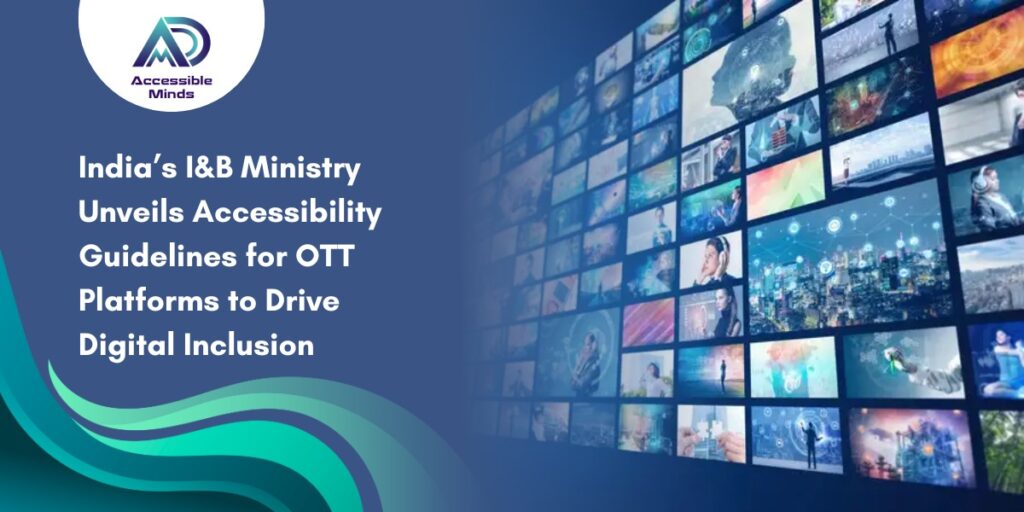On October 7, 2025, Ministry of Information and Broadcasting took a historic step toward building an inclusive digital entertainment ecosystem. The Ministry released the draft Guidelines for Accessibility of Content on Platforms of Publishers of Online Curated Content (OTT Platforms) for persons with hearing and visual impairments.
The goal is simple but powerful: to ensure every Indian, regardless of disability, can fully access and enjoy digital content through Accessible OTT Platforms.The draft guidelines call for mandatory accessibility features such as captions, audio descriptions, and Indian Sign Language (ISL) interpretation, setting the stage for a more equitable digital future.
The Ministry has also invited public feedback on these guidelines until October 22, 2025 at digital-mediamib@gov.in.
Why These Guidelines Matter
India’s OTT sector has exploded in recent years, reaching millions of households across urban and rural regions. But for individuals with hearing or visual impairments, this entertainment revolution has remained largely out of reach.
While traditional media such as television and cinema already follow accessibility norms, the OTT landscape has lacked a unified accessibility framework until now.
The new OTT Accessibility Guidelines bridge this gap by aligning India’s digital entertainment industry with:
- Article 14 of the Constitution of India, guaranteeing equality before the law.
- Rights of Persons with Disabilities (RPwD) Act, 2016, which mandates access to information and communication systems.
- UN Convention on the Rights of Persons with Disabilities, which India has ratified.
- National initiatives such as the Accessible India Campaign (Sugamya Bharat Abhiyan) and the Accessibility Standards for Television Programmes (2019).
This is more than just a policy announcement, it’s a milestone in embedding digital accessibility services into India’s media infrastructure driving OTT Accessibility Compliance nationwide.
What the Draft Accessibility Guidelines Cover
The draft framework outlines clear requirements to ensure an Accessible OTT experience for all users:
1. Audio Description
An audio narration describing visual actions, settings, and gestures will allow people with visual impairments to follow storylines seamlessly.
2. Closed and Open Captions
Captions must include not just spoken dialogue but also meaningful non-verbal sounds like background music or laughter, enabling a richer experience for viewers with hearing impairments.
3. Indian Sign Language (ISL) Interpretation
ISL interpretation should appear in a picture-in-picture format, ideally at the bottom right of the screen, ensuring clear visibility of facial expressions and gestures.
4. Accessible User Interfaces
OTT platforms will be required to ensure their websites, apps, and Smart TV interfaces are compatible with assistive technologies such as screen readers and keyboard navigation. This is where web accessibility services will play a critical role, ensuring platforms meet global standards such as Web Content Accessibility Guidelines (WCAG).
A Phased Implementation Plan
The Ministry has smartly structured the rollout in two phases, balancing ambition with practical feasibility.
Phase I — Within Six Months
- All new content must include at least one accessibility feature (captions, audio description, or ISL).
- Platforms must display accessibility indicators and ensure compatibility across devices.
Phase II — Within 24 Months
- Platforms must make their entire content libraries accessible:
- 30% accessibility within 12 months,
- 60% within 18 months,
- 100% within 24 months.
- 30% accessibility within 12 months,
This structured timeline gives streaming platforms room to adopt digital accessibility services strategically without compromising user experience.
Monitoring and Accountability
To ensure real compliance, the Ministry plans to establish a Monitoring Committee led by a Joint Secretary-level officer. This committee will:
- Conduct quarterly progress reviews,
- Address user grievances, and
- Issue directives to ensure consistent implementation.
OTT publishers will be required to:
- Submit quarterly reports,
- Maintain transparency about accessible content, and
- Actively promote accessibility features on their platforms and marketing materials.
This structured oversight ensures accessibility isn’t just a checkbox — it becomes a sustained commitment to Accessible OTT Platforms.
Collaboration and Awareness: A User-Centric Approach
True accessibility goes beyond technical compliance. The Ministry encourages collaboration with disability rights organizations and user groups to co-create inclusive experiences.
When platforms work hand-in-hand with real users, web accessibility services can be tailored to address genuine barriers, ensuring features are practical, intuitive, and effective. This collaborative approach ensures Accessible OTT is built for real-world use, not just policy compliance.
Exemptions for Certain Content
Recognizing technical limitations, the guidelines offer exemptions for specific content types:
- Live and deferred live events (e.g., sports, news),
- Audio-only content like podcasts, and
- Short videos under 10 minutes where real-time accessibility may be difficult.
This balanced approach ensures inclusivity while accommodating operational realities.
Grounded in Equality, Driven by Innovation
The I&B Ministry’s draft guidelines reaffirm that accessibility is a right, not an afterthought. Making OTT platforms accessible benefits millions of users while opening up new audience segments for platforms.
Globally, accessibility has become a benchmark of quality and responsibility. With this move, India is aligning its entertainment industry with international best practices — and digital accessibility services providers have a critical role to play in this transformation.
For OTT platforms, this is not just about OTT Accessibility Compliance. It’s about innovation, inclusion, and leadership in a rapidly expanding digital economy.
Public Participation Invited
The Ministry has opened the draft for public comments until October 22, 2025. Industry stakeholders, accessibility advocates, and viewers are encouraged to contribute their feedback.
Submissions can be sent in Word or PDF format to: digital-mediamib@gov.in
This is a defining moment for India’s digital entertainment sector. By integrating robust web accessibility services, OTT platforms can ensure that stories, news, and cultural moments are experienced by everyone not just a select few.
Conclusion
The draft accessibility guidelines are a bold and necessary step toward an inclusive digital future. By making captions, audio descriptions, ISL interpretation, and accessible interfaces a standard, India is setting the tone for responsible, people-first innovation.
With the right partnerships in digital accessibility services and a proactive approach, OTT platforms can lead the way in building a more equitable digital media landscape.

